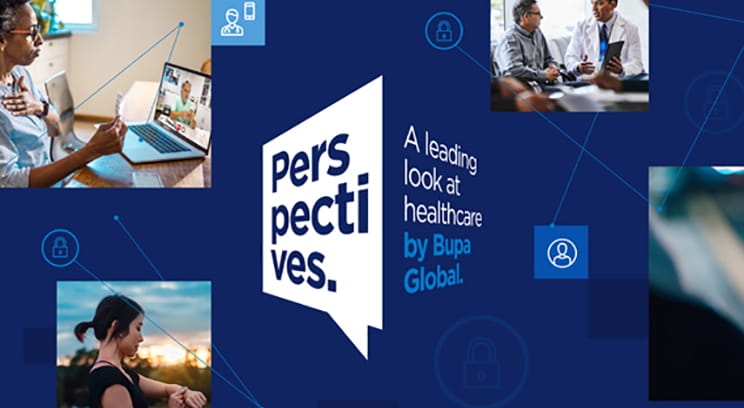Digital health technology has the power to create more inclusive health systems for the future. And while digital solutions can improve access to care, create greater choice for patients, and ultimately reduce health inequalities, we can see that adoption is stalling.
Joining the panel to discuss this topic at a recent Perspectives by Bupa Global event were Inclusion Specialist and Disability Business Adviser, Shani Dhanda; Healthcare Entrepreneur, Founder of Babylon Health and co-Founder of Circle Health Group, Ali Parsa; and Bupa’s Head of Behavioural Insights, Dr Leah Jones.
If we don’t act now to understand what more we can do to encourage adoption, we’ll miss the opportunity to build a more inclusive health system that makes access to care much fairer and more equitable.”
- Dr Leah Jones
In this article, Dr Leah shares her reflections post event, on how to boost digital health adoption and engagement to help create more inclusive workplace cultures.
“Pre-pandemic there was a burst of fitness and wellbeing apps in the preventive space, but that didn’t translate into an explosion in telemedicine as we’d expected because there was no need, and face-to-face care remained the preferred option” says Dr Leah. “However, as the pandemic hit, customers and healthcare providers were forced to go online overnight. Our industry saw a shift in customer behaviour towards telemedicine and things looked promising for the digital healthcare revolution that we’ve been promised for some time”.
This was further backed up in a report by McKinsey in 2021 which showed that consumers were continuing to view telehealth as ‘an important modality for their future care needs’.1 This highlighted that telemedicine use was 38 times higher than pre-pandemic, and 40% of health consumers believed they would continue to use telemedicine.
However, as Dr Leah explains, “Now, as we enter the pandemic recovery stage, we’ve seen adoption plateauing and people are returning to face-to-face care setting preferences. And this is a real challenge for the healthcare industry. If we don’t act now to understand what more we can do to encourage adoption, we’ll miss the opportunity to build a more inclusive health system that makes access to care much fairer and more equitable.”
Reasons for people returning to face-to-face preferences could include concerns around data and privacy; or may be based on previous experiences or a particular health concern; there could be a lack of digital literacy, or potentially financial factors affecting phone or broadband use.
With many businesses investing heavily in providing their employees with access to digital health options, there are some practical tips businesses can follow to encourage greater adoption and boost employee engagement.
Behavioural insights are key
Dr Leah and her team know that behavioural insights are a powerful tool that can be used to boost employee engagement, and that a ‘one-size-fits-all’ approach just doesn’t work.
“Once you know what the barriers are, only then can you begin to work to address them.”
- Dr Leah Jones
“Often, the temptation may be to think ‘we need people to engage, what can we do to engage them? I know, let's do a campaign to raise awareness!’ But that doesn't tackle whatever the actual problem or barrier to using digital health tools may be.” says Dr Leah.
"As with any problem in behavioural science, the first step is to:
- Understand what the barriers and facilitators to uptake are
- Speak to your employees to learn what the engagement issues may be - ask them what they want from their healthcare, what’s stopping them, and what would help them - whether that's via a survey, workshops or focus groups
- Speak to those who are engaging to understand the differences with those who don’t
- Don’t second guess and never assume that you already know the answers
“Once you know what the barriers are, only then can you begin to work to address them – and any intervention recommendations, whether it's information, education, motivational or accessibility, must be based on the scientific evidence from the research. And using this evidence, rather than making assumptions, will give you a better change of increasing engagement - which can save time and effort in the long run.”
Understanding the challenges
Barriers to using these digital tools could range from a perceived lack of need, lack of skills or confidence, financial concerns, security / privacy concerns or could be due to cultural nuances or a disability.
Understanding these barriers may require a change in mindset and focus of the employer, which could also mean a change in communication too.
Employees might need more information about what their digital health options are, how to access them, and the personal health benefits of using them; or they may need practical organisational support to access these resources.
- Work with your healthcare provider to communicate the information, the benefits, and what’s on offer
- Share case studies of those who engage and have positive experiences; modelling by senior members is also important
- Provide talks or workshops for what’s available and how it can be accessed
- Information should be delivered in the way your employees need, on their terms, where they are, and using their language
Choice and flexibility of options
As healthcare providers look towards this digital healthcare revolution, Dr Leah emphasises “Digital technology can be transformative - it can make efficiencies, offer convenience, provide early intervention, and is a major enabler to accessing care. But it’s important to have an option for those that simply cannot (or will not) engage with digital. If customers are expressing a clear preference for face to face, healthcare systems should listen and ensure they are served just as well as the group who are already using digital technology.
“Taking away face-to-face options can really be to the detriment of some people, and that's why it is important to give people choice and flexibility of options.”
- Dr Leah Jones
Looking to the future
Looking to the future, Dr Leah contemplates whether these barriers may change with emerging generations.
“There is a trend which shows that the size of the group of people who don't use digital services is getting smaller and smaller year on year. Will digital access increase with the new emerging generations, and will there still be groups of people that don't engage with digital services? I can imagine the answer will be yes, to both questions. But I can also imagine that the latter won't necessarily be out of reluctance, but instead being due to social inequalities and health inequalities.
“And those wider divisions, that I think we're seeing now, may get bigger. So those barriers to access we see now may change – and potentially a lack of skills and confidence won't necessarily be an issue, but instead it may be a lack of access due to financial issues and circumstances”.
So, as businesses invest in the offering of digital health options, it is important to also consider behavioural insights as a powerful tool to support and boost adoption.
And for healthcare systems or providers, digital options can significantly help to improve accessibility to care, but there will always be customers who prefer face to face settings, so it will be vital to ensure customers choice is at the heart of what we do.
With a Health Psychologist background, Dr Leah worked for 8 years at the UK Health Security Agency in various behavioural science roles, and in the last two years led a team of behavioural scientists on the COVID-19 response in the UK, before joining Bupa in May 2022.
Find out more about Perspectives by Bupa Global
Visit our Perspectives page to catch up all previous recordings from the series, where our panellists share their insights and perspectives on some of the biggest inclusive health themes impacting the healthcare landscape today.



